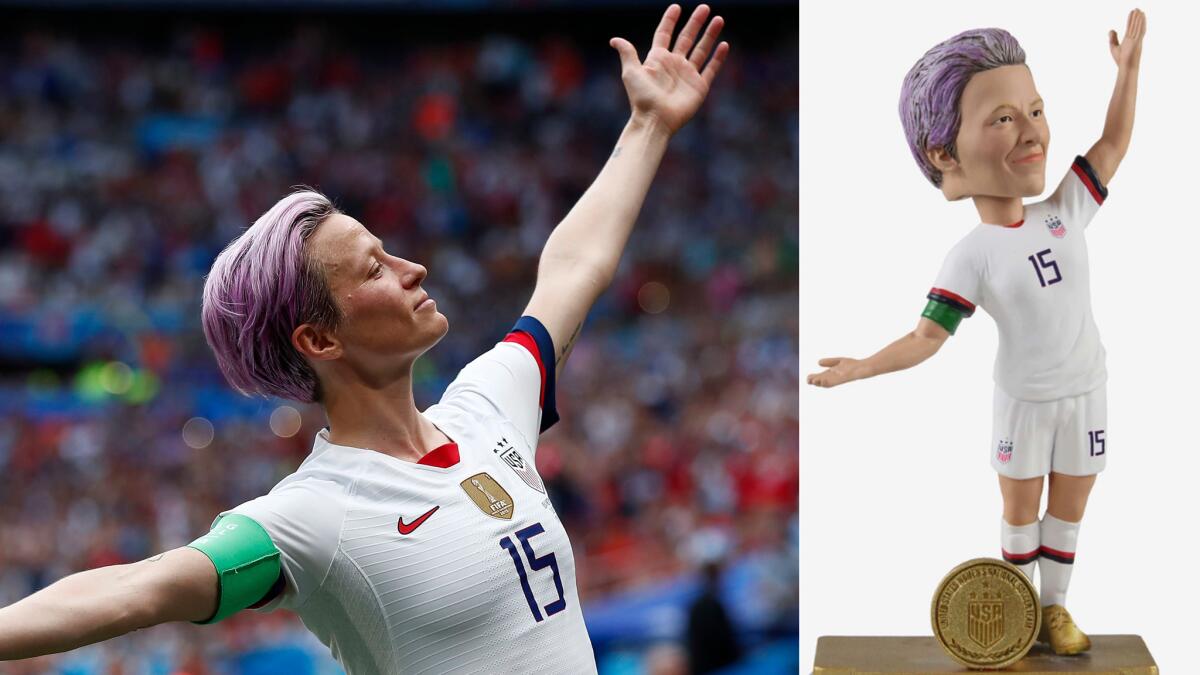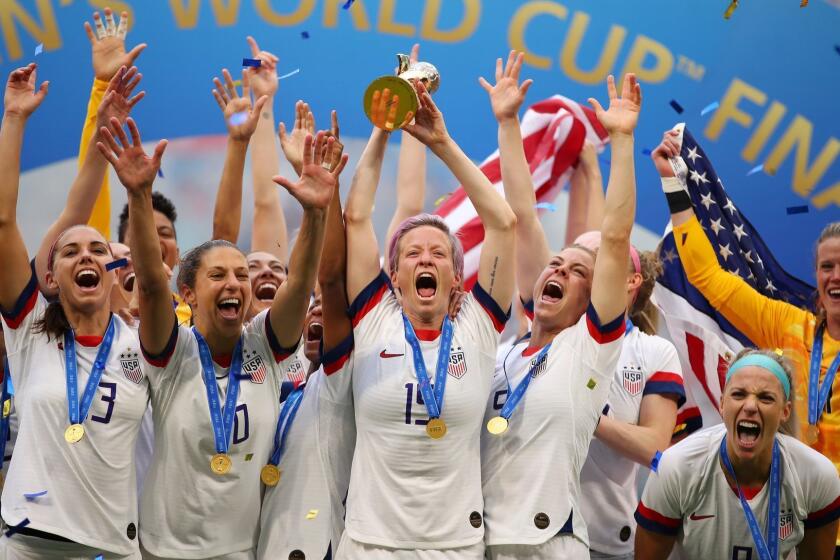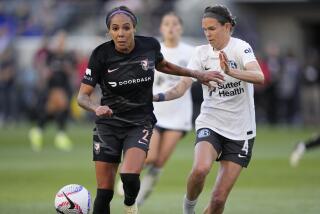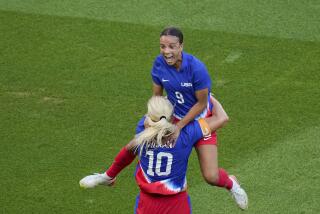U.S. women’s soccer players start to cash in on licensing -- that’s using your bobblehead

In 1999, when the United States won the Women’s World Cup, the iconic pose was that of Brandi Chastain ripping off her jersey, celebrating in her sports bra. The photographs live forever.
In 2019, another U.S. victory featured two iconic poses: Megan Rapinoe spreading her arms outward, almost wider than humanly possible, after scoring against France; and Alex Morgan, delicately lifting her closed hand to her mouth, her pinky extended as if sipping a cup of tea, after scoring against England.
Those photos live on too, but now so does the memorabilia. Those images are reproduced and sold on bobblehead dolls, mugs and a variety of T-shirts, including ones with Morgan’s name and the words “Tea Time” and ones with Rapinoe’s pose and the words “American Badass.”
The NFL players’ union made all this possible.
Equal pay is not the only empowerment vehicle for the U.S. women’s national team. When the USWNT won the Cup four years ago, the wave of commemorative memorabilia never followed, and the players subsequently asserted their marketing rights. The players’ collective licensing revenue was $0 in 2015, but it is expected to top $1 million in 2019.
“The cool thing is that profits are going toward players,” forward Christen Press said, “as opposed to most memorabilia that you can buy through the national team. That doesn’t trickle down to the players.”
When the players negotiated their current collective bargaining agreement, they asked U.S. Soccer for control of the rights to their names and likenesses. The players had won the Cup, after all, but where were the player T-shirts?
The Victory Tour for team USA will kick off at the Rose Bowl against Ireland.
Becca Roux, executive director of the USWNT players’ association, said she understood that television rights and ticket sales drove the revenue at U.S. Soccer. The federation, she said, saw little value in licensing rights.
“Licensing is a pretty laborious thing to make money out of,” Roux said. “But it’s also a really great marketing tool.
“I always knew when the next Disney movie was coming out because of the Happy Meal.”
In 2017, as the USWNT signed its new contract and secured its licensing rights, the National Football League Players Assn. launched a sports marketing venture called Rep Worldwide. The pitch, in a nutshell: We already know how to market athletes, so let us market yours.
“Think of how many baseball bobbleheads are out there in the world. That hadn’t really been done for the women’s national team,” said Steven Scebelo, vice president of licensing and business development at NFL Players Inc., the union’s marketing arm.
The USWNT players’ union had no sales data and no relationships with vendors, and Roux was the lone full-time employee. The NFL players’ union had 125 employees, including 30 alone at Players Inc.
The soccer players were impressed by the pitch, but also by the commitment to work with players who did not want to simply hand over their rights and wait for a licensing check. The WNBA players’ union also signed with Rep Worldwide, and Scebelo said the USWNT and WNBA unions each received an ownership stake in the company.
Press said Meghan Klingenberg, a former USWNT defender and current player for the Portland Thorns of the National Women’s Soccer League, reviews every proposed licensing contract – not only to approve the terms of the deal, but to see whether the players should want to affiliate with the company.
“We have a very special group of players since 2015 that worked really hard to reestablish our players’ association and run it like a business,” Press said. “While we were empowering ourselves and believing in our own value, the kickback that we got was this amazing learning opportunity.”
Press designed her own T-shirts through one of the licensees. Press, Klingenberg, Rapinoe and teammate Tobin Heath in June launched a clothing brand called re-inc independent of the USWNT and Rep Worldwide.
“I’ve learned how to start a small business,” Press said.
The USWNT had 22 licensing deals in place for the World Cup, according to Scebelo, and agreements with five more companies are pending.
“The Monday after they won the Cup, there was one in particular that said, ‘We should have taken this six months ago,’” he said.
Each NFL player received a base payment of $17,662 in licensing royalties last year, according to documents filed by the NFLPA with the U.S. Department of Labor. In a league in which the average salary is close to $3 million and the minimum salary is $495,000, individual licensing royalties among most of the roughly 2,200 players are relatively minimal.
That should not be the case for the USWNT. The players on the national team earn a $100,000 base salary from U.S. Soccer, with incentive bonuses. But of the 23 players on the World Cup roster, Roux said only 18 got that base salary.
Roux said between 25 and 40 players would be eligible to share in the licensing revenue. If shared equally, that would essentially be a bonus of at least $25,000 per player.
“This is a new opportunity to bring in supplemental revenue that hopefully can change the landscape of what it means to be a women’s soccer player,” Press said, “and impact the quality of life that women’s soccer players have.”
The players hope the blizzard of merchandise – from shirts to scarves, trading cards, player figurines and oversized replicas of player heads – can help keep interest in soccer vibrant outside of the World Cup and Olympics. Their robust presence on social media – Morgan alone has 9 million followers on Instagram and 4 million on Twitter – can help persuade companies that the window to sell USWNT merchandise does not close after those major events, Scebelo said.
On Saturday, the USWNT makes its first appearance since winning the World Cup, facing Ireland in an exhibition match at the Rose Bowl.
“I’ve really enjoyed seeing the products that the fans buy and use at the stadium,” Press said. “You feel personally more connected and attached to that stuff than the more generic merchandise.
“We’re more likely to go up to that person and say we really appreciate that.”








